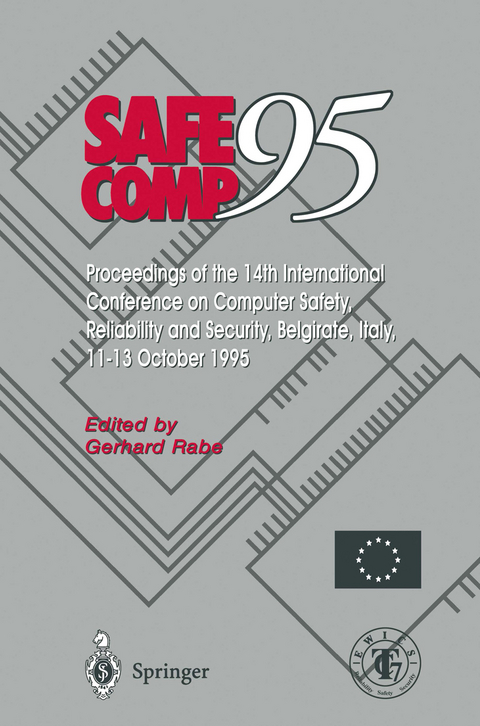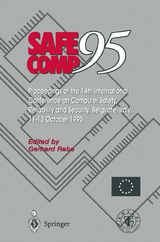Safe Comp 95
Springer Berlin (Verlag)
978-3-540-19962-5 (ISBN)
Session 1: General Issues, Guidelines.- Software Best Practices in Dependable Systems: The European Research Projects ENCRESS, OLOS and ESPITI From a Partner's Perspective.- Assessment on the Basis of Standards - Gaps and How to Bridge Them.- Session 2: Safety Analysis.- Safety Analysis for Requirements Specifications: Methods and Techniques.- A Guideline for HAZOP Studies on Systems Which Include a Programmable Electronic System.- An Automated Code-Based Fault-Tree Mitigation Technique.- Session 3: Formal Methods.- Formal Support for the Safety Analysis of Requirement Models.- Modelling Fault Trees Using Petri Nets.- The Application of Formal Methods to Railway Signalling Systems Specification and the ESPRIT III Project CASCADE.- Accessible Formal Method Support for PLC Software Development.- Session 4: Human and Legal Aspects.- Eliminating the Unexpected.- Cognitive Diversity: A Structured Approach to Trapping Human Error.- Legal Aspects of Safety Critical Systems.- Invited Paper.- A Bayesian Model that Combines Disparate Evidence for the Quantitative Assessment of System Dependability.- Session 5: Design.- Six Steps Towards Provably Safe Software.- Formally Verified Firmware Modules for Industrial Process Automation.- Session 6: Assessment.- Programmable Electronic Controllers (PEC) Performance Assessment - An Approach for Reliability Quantification.- BOOTSTRAP: Software Process Assessment - Experiences and Further Developments.- Analysis and Assessment of Advanced Road Transport Telematic Systems.- Session 7: Safe Software.- Loops for Safety Critical Applications.- Ontario Hydro's Experience with New Methods for Engineering Safety Critical Software.- Is Software Safe to Fly?.- Session 8: Applications I.- A Software Development Approach for Robotics ControlSystems.- An Attempt to Evaluate Functional Diversity Employed in a Reactor Protection System.- Requirements Analysis and Safety: A Case Study (Using GRASP).- Session 9: Applications II.- Neural Nets and Diversity.- On-Line Software Error Detection by Executable Assertions: From Theory to Practice.- The Use of Animated Graphical Simulation Techniques to Facilitate Safe Operation, Assembly and Disassembly of Safety Critical Equipment and Systems.- Invited Paper.- An Industrial View of Requirements Engineering and Safety.- Session 10: Case Studies.- Safety Cases for Software Application Reuse.- The SHIP Safety Case Approach.- Safety Case: Structure and Role.- Session 11: Validation and Verification.- Practical Approach for the Evaluation of Safety Related Programmable Electronics.- An Experience in Formal Verification of Safety Properties of a Railway Signalling Control System.- Dependability of Iterative Software: A Model for Evaluating the Effects of Input Correlation.- The Verification of Compiled Code.- Author Index.
| Erscheint lt. Verlag | 13.10.1995 |
|---|---|
| Zusatzinfo | XII, 516 p. 59 illus. |
| Verlagsort | London |
| Sprache | englisch |
| Maße | 155 x 235 mm |
| Gewicht | 796 g |
| Themenwelt | Informatik ► Netzwerke ► Sicherheit / Firewall |
| Mathematik / Informatik ► Informatik ► Software Entwicklung | |
| Informatik ► Theorie / Studium ► Kryptologie | |
| Technik ► Elektrotechnik / Energietechnik | |
| Schlagworte | Automation • Complexity • Computer • Design • Diversity • Formal Method • formal methods • Modeling • Reliability • Requirements Engineering • Simulation • Software • Standards • structured analysis • Validation • verification |
| ISBN-10 | 3-540-19962-4 / 3540199624 |
| ISBN-13 | 978-3-540-19962-5 / 9783540199625 |
| Zustand | Neuware |
| Haben Sie eine Frage zum Produkt? |
aus dem Bereich




